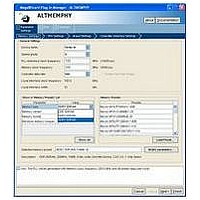IPR-HPMCII Altera, IPR-HPMCII Datasheet - Page 124

IPR-HPMCII
Manufacturer Part Number
IPR-HPMCII
Description
IP CORE Renewal Of IP-HPMCII
Manufacturer
Altera
Datasheet
1.IP-HPMCII.pdf
(176 pages)
Specifications of IPR-HPMCII
Software Application
IP CORE, Memory Controllers, SDRAM
Supported Families
Arria II GX, HardCopy III, Stratix III, Stratix IV
Core Architecture
FPGA
Core Sub-architecture
Arria, HardCopy, Stratix
Rohs Compliant
NA
Lead Free Status / RoHS Status
na
- Current page: 124 of 176
- Download datasheet (4Mb)
7–8
External Memory Interface Handbook Volume 3
Section II. DDR3 SDRAM Controller with ALTMEMPHY IP User Guide
■
■
■
■
■
■
■
When a single-bit or double-bit error occurs, the ECC logic triggers the ecc_interrupt
signal to inform you that an ECC error has occurred. When a single-bit error occurs,
the ECC logic issues an internal read to the error address, and performs an internal
write to write back the corrected data. When a double-bit error occurs, the ECC logic
does not do any error correction but it asserts the local_rdata_error signal to
indicate that the data is incorrect. The local_rdata_error signal follows the same
timing as the local_rdata_valid signal.
Enabling auto-correction allows the ECC logic to hold off all controller pending
activities until the correction is completed. You can choose to disable auto-correction
and schedule the correction manually when the controller is idle to ensure better
system efficiency. To manually correct ECC errors, do the following:
1. When an interrupt occurs, read the SBE_ERROR register. When a single-bit error
2. Read out the ERR_ADDR register.
3. Correct the single-bit error by doing one of the following:
Partial Writes
The ECC logic supports partial writes. Along with the address, data, and burst
signals, the Avalon-MM interface also supports a signal vector, local_be, that is
responsible for byte-enable. Every bit of this signal vector represents a byte on the
data-bus. Thus, a logic low on any of these bits instructs the controller not to write to
that particular byte, resulting in a partial write. The ECC code is calculated on all
bytes of the data-bus. If any bytes are changed, the ECC code must be recalculated
and the new code must be written back to the memory.
For partial writes, the ECC logic performs the following steps:
A latency increase of one clock for both writes and reads.
Detects and corrects all single-bit errors.
Detects all double-bit errors.
Counts the number of single-bit and double-bit errors.
Accepts partial writes, which trigger a read-modify-write cycle, for memory
devices with DM pins.
Is able to inject single-bit and double-bit errors to trigger ECC correction for
testing and debugging purposes.
Generates an interrupt signal when an error occurs.
occurs, the SBE_ERROR register is equal to one.
■
or
■
Issue a dummy write to the memory address stored in the ERR_ADDR register. A
dummy write is a write request with the local_be signal zero, that triggers a
partial write which is effectively a read-modify-write event. The partial write
corrects the data at that address and writes it back.
Enable the ENABLE_AUTO_CORR register using the CSR interface and issue a read
request to the memory address stored in the ERR_ADDR register. The read
request triggers auto-error correction to the memory address stored in the
ERR_ADDR register.
Chapter 7: Functional Description—High-Performance Controller II
December 2010 Altera Corporation
Block Description
Related parts for IPR-HPMCII
Image
Part Number
Description
Manufacturer
Datasheet
Request
R

Part Number:
Description:
IP NIOS II MEGACORE RENEW
Manufacturer:
Altera
Datasheet:

Part Number:
Description:
IP CORE Renewal Of IP-XAUIPCS
Manufacturer:
Altera
Datasheet:

Part Number:
Description:
IP CORE Renewal Of IP-10GETHERNET
Manufacturer:
Altera
Datasheet:

Part Number:
Description:
IP CORE Renewal Of IP-ASI
Manufacturer:
Altera
Datasheet:

Part Number:
Description:
IP CORE Renewal Of IP-CIC
Manufacturer:
Altera
Datasheet:

Part Number:
Description:
IP CORE Renewal Of IP-CRC
Manufacturer:
Altera
Datasheet:

Part Number:
Description:
IP CORE Renewal Of IP-ED8B10B
Manufacturer:
Altera
Datasheet:

Part Number:
Description:
CPLD, EP610 Family, ECMOS Process, 300 Gates, 16 Macro Cells, 16 Reg., 16 User I/Os, 5V Supply, 35 Speed Grade, 24DIP
Manufacturer:
Altera Corporation
Datasheet:

Part Number:
Description:
CPLD, EP610 Family, ECMOS Process, 300 Gates, 16 Macro Cells, 16 Reg., 16 User I/Os, 5V Supply, 15 Speed Grade, 24DIP
Manufacturer:
Altera Corporation
Datasheet:

Part Number:
Description:
Manufacturer:
Altera Corporation
Datasheet:










